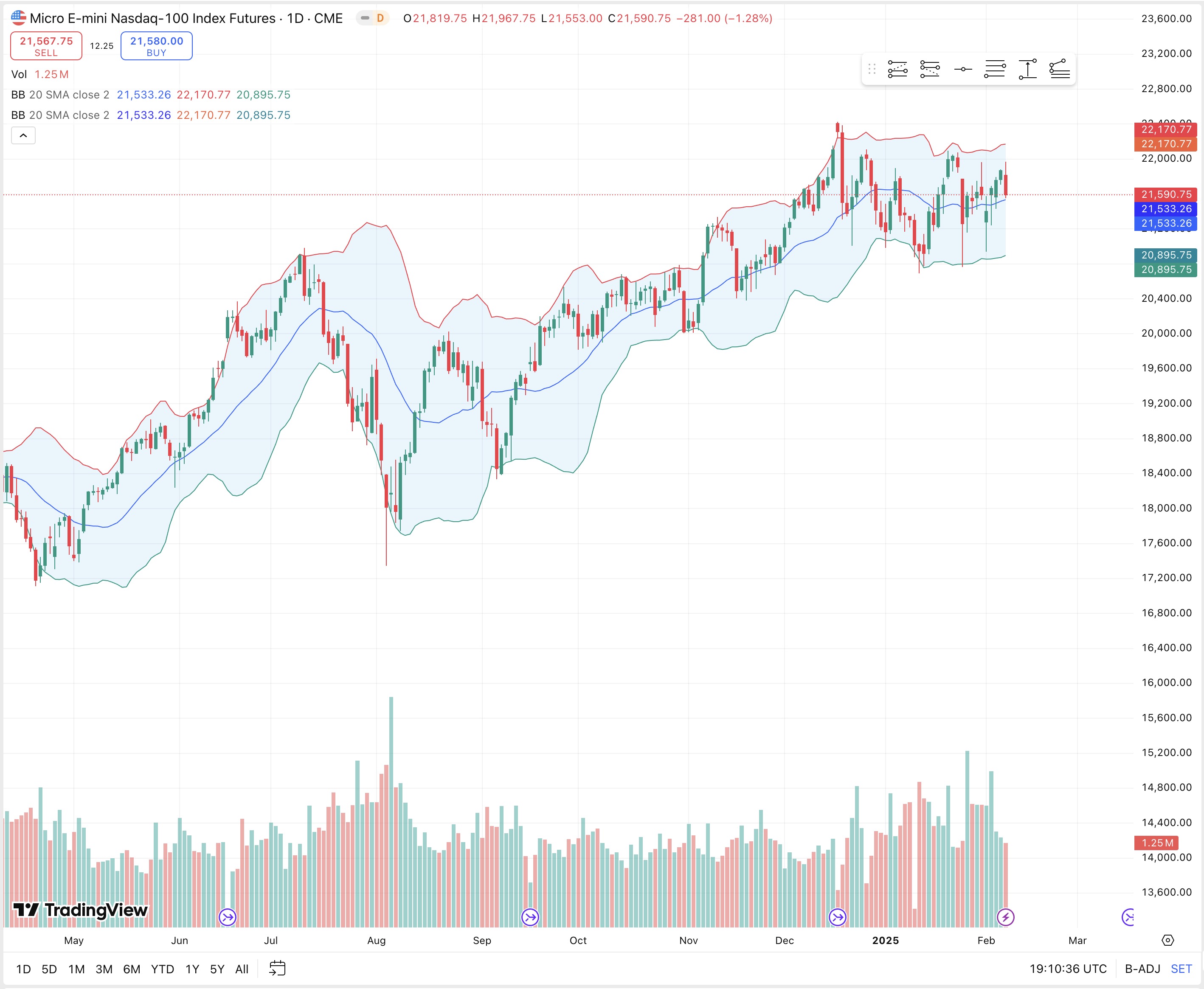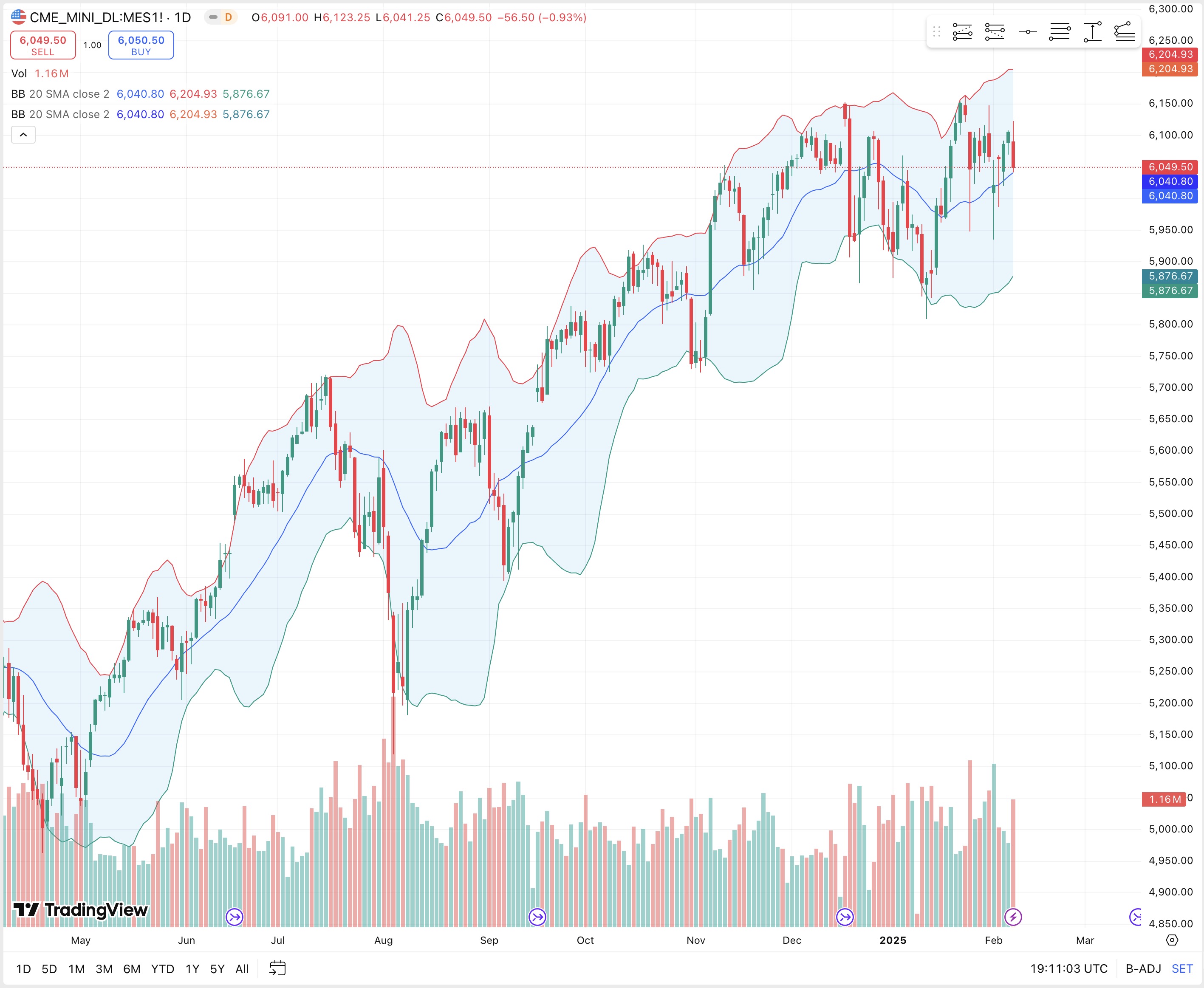Introduction
Trading futures and options on futures can be a highly rewarding strategy, but without proper risk management, it can also lead to large drawdowns. Like me, many traders, especially those focused on day trading /MNQ (Micro E-mini Nasdaq-100) futures, experience the emotional rollercoaster of massive intraday swings, which can make it difficult to maintain long-term profitability.
In this guide, we will compare /MNQ vs. /MES (Micro E-mini S&P 500) futures trading, break down an effective short strangle options strategy, and explore risk management techniques like hedging with futures and proper position sizing.
/MNQ vs. /MES: Which Futures Market is Best for You?
Key Differences Between /MNQ and /MES
| Factor | /MES (Micro S&P 500) | /MNQ (Micro Nasdaq-100) |
|---|---|---|
| Volatility | Lower (15–25% IV) | Higher (25–40% IV) |
| Daily Range | ~30-50 points/day | ~100-200 points/day |
| Margin Required | Lower | Higher |
| Liquidity | High (tight spreads) | Medium (wider spreads) |
| Risk of Stop-Outs | Lower (smoother trends) | Higher (aggressive moves) |
| Strike Selection (Options) | More predictable | Unpredictable |
| Best For | Trend following, options hedging | High IV premium collection, fast trades |
Why /MNQ Can Be Risky for Day Trading
The Nasdaq-100 index is dominated by high-volatility stocks like Tesla (TSLA), Nvidia (NVDA), and Amazon (AMZN), which can lead to massive intraday swings. While this can create great opportunities, it also increases the risk of being stopped out before the market reverses.
Common Pitfalls of Trading /MNQ Futures:
- Overleveraging on high-volatility contracts (see Figure 1).
- Getting stopped out frequently due to rapid swings.
- Failing to hedge against extreme moves.

Why /MES is a Safer Alternative:
- The S&P 500 is more diversified, leading to smoother trends (see Figure 2).
- Better for systematic strategies like trend-following or options hedging.
- Lower risk of account blow-ups compared to /MNQ.

Choosing the Right Futures Market for Your Strategy
- If you want big swings and fast profits → Trade /MNQ.
- If you want a more stable approach with fewer stop-outs → Trade /MES.
- If you use options strategies (like short strangles) → /MES works better for risk management.
Profitable Short Strangle Strategy on /MES Options
A short strangle is a delta-neutral strategy where you sell both a call and a put at 1 standard deviation (≈16 delta) strikes to collect premium.
Why Short Strangles Work Well on /MES
High win rate (≈80%) – Most options expire worthless. Theta decay helps profits – You make money as time passes. Less risk than trading naked futures – Since you’re neutral, you’re not betting on direction.
Setting Up the Short Strangle
- Sell a Call Option at ~16 Delta
- Sell a Put Option at ~16 Delta
- 45 Days to Expiration (DTE) → Best balance between premium & risk.
- Exit at 50% profit or 21 DTE to avoid gamma risk.
- Use a 200% premium stop-loss (If collected $5, stop at -$10).
Managing Risk: Stop-Loss & Rolling
- If the position moves against you, roll the untested side (e.g., if the call is in trouble, roll the put closer).
- If IV spikes, consider rolling the entire position to maintain a high probability of profit.
- Avoid trading in ultra-low IV environments (VIX below 15).
Using Futures to Hedge Short Strangle Risk
A major concern with short strangles is the potential for large directional moves wiping out profits. One solution is to hedge with futures contracts.
How to Hedge with Futures
Scenario 1: Market Drops Hard (Put side is in trouble)
- Go short 1 /MES contract to hedge against further downside moves.
- If the market rebounds, exit the hedge and let the short strangle profit.
Scenario 2: Market Rallies Hard (Call side is in trouble)
- Go long 1 /MES contract to hedge against further upside moves.
- Close the hedge when the market stabilizes.
Futures vs. Rolling for Adjustments
- If IV is low, rolling works better than using futures.
- If IV is high, hedging with futures is more efficient than rolling.
Position Sizing: Protecting Your Portfolio
No matter how good a strategy is, position sizing is crucial to avoid large drawdowns.
Ideal Position Sizing for Futures
- Risk no more than 1-2% of your account per trade.
- If your account is $50,000, risking $500-$1,000 per trade is reasonable.
- Avoid overleveraging – One bad move can blow up your account.
Position Sizing for Short Strangles
- Sell only as many contracts as your account can handle.
- Each short strangle should risk no more than 2% of your total portfolio.
- If you trade multiple short strangles, keep exposure balanced (e.g., don’t only short puts).
Conclusion: The Best Strategy for Long-Term Success
If you’re frustrated with day trading /MNQ, moving to /MES futures or short strangles on /MES options can provide a more stable path to profitability.
The Best Approach for Most Traders:
- If you want smoother trading, switch from /MNQ to /MES futures.
- If you want consistent income, trade short strangles on /MES.
- Use futures contracts to hedge against large directional moves.
- Always maintain proper position sizing to avoid large drawdowns.
By focusing on high-probability trades, risk management, and strategic hedging, you can rebuild and grow your trading account without excessive risk.
Are you currently trading /MNQ, /MES, or short strangles?